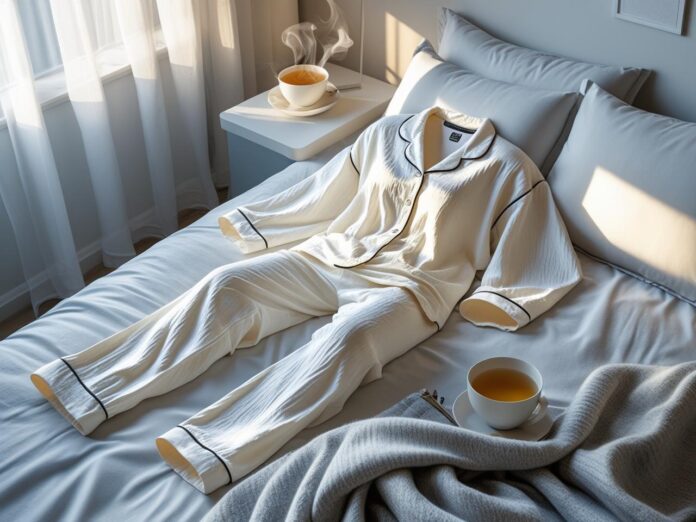Introduction to Pyjamaspapper
Pyjamaspapper, translating literally to “pajama paper” in Swedish, refers to a specific type of lightweight, breathable fabric traditionally used for sleepwear in Sweden. This textile has become synonymous with comfortable, functional nightwear throughout Scandinavia.
Key Characteristics of Pyjamaspapper
-
Typically made from 100% cotton or cotton blends
-
Features a distinctive soft, slightly crinkled texture
-
Known for excellent moisture-wicking properties
-
Maintains optimal body temperature throughout sleep cycles
This comprehensive guide explores the origins, manufacturing processes, modern applications, and proper care of pyjamaspapper fabrics.
Historical Development of Pyjamaspapper
Early Origins (19th Century)
Pyjamaspapper emerged during Sweden’s textile industrialization period when:
-
Cotton became more widely available in Scandinavia
-
Nightwear transitioned from wool to lighter materials
-
The first specialized sleepwear fabrics were developed
Mid-20th Century Popularity
The fabric gained widespread adoption due to:
-
Post-war focus on functional home textiles
-
Swedish design emphasis on practicality and comfort
-
Increased domestic textile production capabilities
Contemporary Status
Today pyjamaspapper remains popular for:
-
Children’s sleepwear due to its breathability
-
Summer pajama sets in adult collections
-
Hospital and healthcare garments
Manufacturing Process and Technical Specifications
Material Composition
Modern pyjamaspapper typically consists of:
-
100% combed cotton (premium versions)
-
Cotton-polyester blends (more affordable options)
-
Occasionally includes elastane for stretch
Weaving Techniques
The distinctive texture comes from:
-
Special low-tension weaving methods
-
Controlled shrinking processes
-
Minimal finishing treatments to preserve natural fibers
Quality Standards
Authentic pyjamaspapper should meet:
-
Oeko-Tex Standard 100 certification
-
Swedish Textile Standards (STS) compliance
-
EU safety regulations for sleepwear fabrics
Benefits of Pyjamaspapper Sleepwear
Thermoregulation Properties
-
Effectively wicks moisture away from skin
-
Provides insulation without overheating
-
Maintains comfort across varying bedroom temperatures
Durability and Longevity
-
Withstands frequent washing
-
Resists pilling better than standard cotton
-
Maintains shape after extended use
Health and Safety Advantages
-
Hypoallergenic material suitable for sensitive skin
-
Naturally flame-resistant properties
-
No chemical softeners required
Comparing Pyjamaspapper to Other Sleepwear Fabrics
| Fabric Type | Breathability | Durability | Moisture Wicking | Typical Use |
|---|---|---|---|---|
| Pyjamaspapper | Excellent | Very Good | Excellent | Year-round sleepwear |
| Flannel | Good | Good | Fair | Winter sleepwear |
| Silk | Excellent | Fair | Good | Luxury sleepwear |
| Microfiber | Fair | Excellent | Good | Athletic sleepwear |
Proper Care and Maintenance
Washing Instructions
-
Machine wash at 40°C (104°F) maximum
-
Use mild, eco-friendly detergents
-
Avoid fabric softeners to maintain texture
Drying Recommendations
-
Line drying preserves fabric integrity
-
If using dryer, select low heat setting
-
Remove promptly to minimize wrinkles
Storage Tips
-
Fold rather than hang to maintain shape
-
Store in breathable cotton bags
-
Avoid plastic containers that trap moisture
Where to Purchase Authentic Pyjamaspapper Products
Reputable Swedish Brands
-
Klippan Yllefabrik
-
Ekens Linneweveri
-
Svenskt Tenn
International Retailers
-
Nordiska Kompaniet (worldwide shipping)
-
Scandinavian Design Center stores
-
Selected specialty sleepwear boutiques
Identifying Genuine Products
Look for:
-
“Genuine Pyjamaspapper” labeling
-
Swedish textile certification marks
-
Natural fiber content disclosures
Modern Applications Beyond Sleepwear
Healthcare Uses
-
Hospital patient gowns
-
Elderly care nightwear
-
Post-surgical recovery garments
Home Textile Innovations
-
Lightweight summer blankets
-
Bed liners for temperature regulation
-
Lounge and loungewear collections
Sustainable Developments
-
Organic cotton versions
-
Recycled fiber blends
-
Closed-loop production initiatives
Frequently Asked Questions
What makes pyjamaspapper different from regular cotton?
The specialized weaving process creates a more breathable, textured fabric optimized for sleep comfort.
Is pyjamaspapper suitable for all seasons?
While ideal for summer, layered versions work well in colder months too.
How can I verify authentic pyjamaspapper?
Check for Swedish manufacturing labels and textile certifications.
Does the fabric require special care?
Avoid high heat and fabric softeners to maintain its unique properties.
Why has pyjamaspapper remained popular?
Its combination of comfort, durability, and temperature regulation continues to meet Swedish quality standards.
Conclusion
Pyjamaspapper represents a successful intersection of traditional textile knowledge and modern sleep science. Its continued popularity in Sweden and growing international recognition testify to its functional advantages. As sleep health receives greater attention globally, this distinctive Scandinavian fabric is poised for wider adoption.

